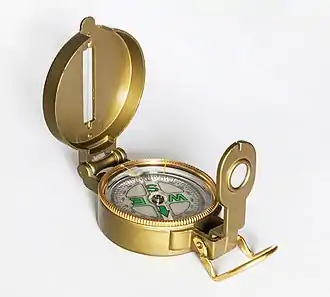Marching line
Marching lines are a pair of lines drawn on the glass of a compass, and arranged at 45 degrees to each other. These are an essential component in hiking through the wilderness. Most modern compasses have adjustable luminous marching lines.[1][2][3][4][5][6][7][8][9][10][11][12][13]

A liquid filled compass.
History
See also
References
- Amir Aczel, The Riddle of the Compass: The Invention that Changed the World, ISBN 0-15-600753-3
- Admiralty manual of navigation, Chapter XXV "The Magnetic Compass (continued) the analysis and correction of the deviation", His Majesty's Stationery Office, London, 1914.
- Paul J. Gans, "Compass" The Medieval Technology Pages
- Frances and Joseph Gies, Cathedral, Forge, and Waterwheel subtitled "Technology and Invention in the Middle Ages".
- Frederic Lane, "The Economic Meaning of the Invention of the Compass", American Historical Review, vol. 68, pp. 605–617 (1963)
- Joseph Needham, Colin A. Ronan: The Shorter Science & Civilisation in China Vol 3 Chapter 1 "Magnetism and Electricity".
- Petra G. Schmidl Two Early Arabic Sources on the Magnetic Compass
- Science Friday, "The Riddle of the Compass" (interview with Amir Aczel, first broadcast on NPR on May 31, 2002).
- The Tides by Sir William Thomson (Lord Kelvin)
- Williams, J.E.D. From Sails to Satellites. New York: Oxford University Press, 1992.
- "Geomagnetism | U.S. Geological Survey". www.usgs.gov.
- Evening Lecture To The British Association At The Southampton Meeting on Friday, August 25, 1882 . Refers to compass correction by Fourier series.
- Arrick Robots. Robotics.com Example implementation for digital solid-state compass. ARobot Digital Compass App Note
This article is issued from Wikipedia. The text is licensed under Creative Commons - Attribution - Sharealike. Additional terms may apply for the media files.